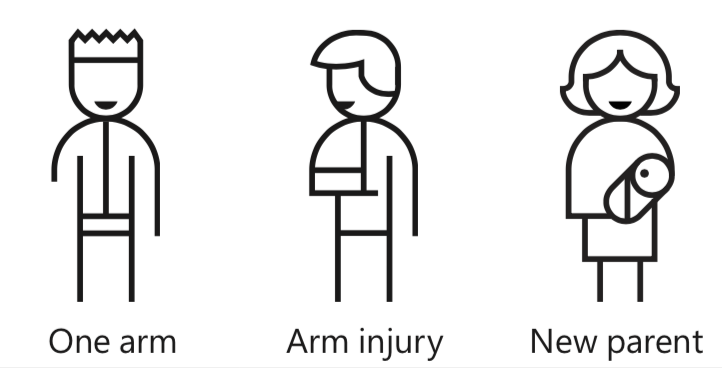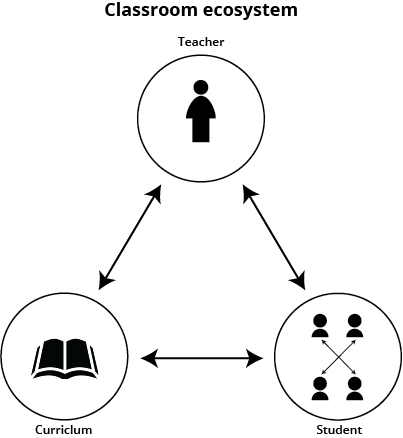At the end of a 72-hour race to complete the Student Design Challenge (SDC) hosted by Microsoft at IxDA this year, I was prompted to think about how my experience could not only benefit future designers, but also public school teachers. The challenge was to design an interactive way to teach rhythm to a student with a mobile impairment disability using Microsoft’s Inclusive Design toolkit. I was placed on a team of students I had never met before and we were tasked with creating a 3-minute pitch in the form of a video. After our final presentation, Ashley Walls, the member of Microsoft’s team responsible for chronicling the SDC, asked my team about what we had learned and what inclusive design meant to us now. As I come to the Interaction Design world with years of experience as an educator, the teacher experience naturally came up. Ashley asked me if inclusive design would be a useful training tool for teachers. Instinctually, I answered, “Yes.” I knew that the experience had opened my mind up to new ways of thinking. But, now I needed to unpack just what might be gleaned from it all.
As I highlighted in my last blogpost, I am interested in reframing the act of curriculum design and teaching and resituating it in the context of design. Reflective educators are, in fact and practice, designers. So, how might imagining an inclusive design mindset be beneficial to teachers and ultimately, their students?
In this post, I will write about:
- Inclusive Design,
- the Design of inclusive classrooms,
- An inclusive design mindset,
- What now?
Inclusive Design
At the start of the challenge, Margaret Price launched our experience with a presentation on inclusive design. Inclusive design is a methodology that is about valuing a diversity of experiences and abilities in the development of a product as well as in its future use. Designers should recognize that when accessibility issues are an add-on after the product has been developed, it is actually too late. Microsoft’s call-to-action is for all designers to begin their designs from the mindset of designing for those with the greatest disability.
The greatest revelation for me was when Margaret reframed disability from one of personal attribute to one that is context-dependent. In this new frame, disability moves from a fixed qualifier to one that describes a mismatched interaction. From this, one can extrapolate and say that you can see disabilities on a spectrum of timescale, from permanent to temporary to situational. For example, a person might have one arm (permanent), a broken arm (temporary) or be carrying a child (situational).

An example of a persona spectrum from Microsoft Design’s Inclusive Design toolkit
In Margaret’s own words during her talk on Inclusive Design, reframing the definition of disability from a health condition or personal attribute to, “a mismatch between the needs of an individual and a product, service, social structure, culture, or environment is huge because we all experience these mismatches on a day-to-day level whether they’re permanent, temporary or situational. Everyone in this room [in the talk] at some point probably today or definitely in your lives has an emotional story of feeling excluded at one point or another.”
Inclusive design methods are a great addition to human-centered design methodologies. Microsoft’s mission to empower designers to address accessibility in a meaningful and empathetic way is inspiring. Taking the time to learn upfront how the world’s most physically and socially excluded individuals adapt to their environments will help a diverse number of people achieve more than they ever thought possible.
But what does this have to do with teachers?
Design of inclusive classrooms
It may seem obvious that teachers should be concerned with designing inclusive classrooms. Isn’t it a teacher’s primary goal to educate her students wherever their physical, emotional and cognitive lives are, and help them to grow into powerful, confident adults? Regardless of intent, it takes superhuman emotional and intellectual strength to design a class for all students to learn regardless of their current dispositions and capabilities.
The early 90s saw a rise in concern about accessibility by design by appropriating the concept of Universal Design in architecture into education. Universal design (UD) and universal design learning (UDL) both take a proactive stance in designing for all. In addition, in 1990 the Individuals with Disabilities Education Act was introduced. In practical terms for teachers, this meant teachers were mandated to design curriculum with individual student needs in mind. In addition to UDL, in the last 20 years, differentiated instruction (DI) in the classroom has also provided a framework for opening up classroom experiences and accessibility issues to more diverse learners.
Both UDL and DI provide educators with a set of ideals to reach more learners through modifications of curriculum. UDL is based on research that states that no two brains are the same. DI recognizes that learners differ according to factors including things like interest, culture, and gender. They both offer guides for ways to think, prepare, and respond during class.
The internet is thick with text, frameworks, and resources on these inclusive classroom methodologies. In my experience as an educator, I have participated in numerous professional development workshops meant to teach teachers how to use those resources to design more inclusive classrooms. There are checklists, videos of best practices, and experts willing to give sage advice.
So, what can having an inclusive design mindset as imagined by Microsoft offer teachers?
An inclusive design mindset for teachers
Part of my role as a public educator over the last decade has been to train teachers to build inclusive classroom ecosystems. What this means in practice is complex and context-dependent. However, the heart of it is that I believe teachers in public schools are responsible for facilitating environments that value and honor all students, regardless of background and ability. In my experience, I know this is challenging. How do you respond in a moment when there’s conflict between students based on background or ability? What happens if a student triggers my own sense of self? How might I plan for this and develop a community that is simultaneously respectful and honest about the impact choices made in the heat of the moment have on the community?
The frameworks and methodologies of UDL and DI try to address this. Plan for a range of abilities, past experiences, personalities, and whatever else might come up in a heterogeneous classroom. Like I noted above, there are lots of smart people working on this. But in my humble opinion, I feel like there’s a huge gap that an inclusive design mindset might fill: the real-time experimentation that the experience of teaching requires.
Let me explain.
What happens when I plan things using a best practice? What impact does that have on creativity, responsiveness, and flexible thinking?
As stated in Microsoft’s Inclusive Design toolkit,
“Learning how people adapt to the world around them means spending time understanding their experience from their perspective.
When done well, we can recognize more than just the barriers that people encounter. We also recognize the motivations that all people have in common.”
An inclusive design mindset is fundamentally participatory. Inclusivity is co-created. It can’t be something that is just pre-designed or pre-prescribed by an expert from outside the classroom who knows best. Because the people who know best (the students and classroom teacher) are the ones who are trying to figure out how to adapt to their specific classroom environment.
This means that teachers need to practice an inclusive design mindset, day-in and day-out. There needs to be space to reflect on what the community can learn from the most excluded from a constantly evolving community of learners.
In the model of the classroom ecosystem below that was popularized in a seminal work on inclusive classrooms called “Adding it up: Helping Children Learn Mathematics”, one can see a simplified version of the entities that interact in a classroom. There’s a teacher, students and curriculum, all situated in a classroom. ecosystem.

UDL and DI help teachers to shift their mental models of disability from thinking that disabled students are broken to the concept that it’s the curriculum that is broken. Teachers need to modify and accommodate given the diversity they deal with every day. An inclusive design mindset takes this a step further in its reframe of disability from personal attribute to one of mismatched interaction.
This means that teachers can shift their focus from just the nodes of the map (curriculum, teacher and student) to the interactions (all of the arrows). Now, there are more opportunities for conceptualizing how to design a more inclusive classroom. It can be in the student-to-student interaction, how the teacher responds, how students access the curriculum, and so on.
In my work with teachers, I’ve noticed that when teachers design more inclusive lessons, they often start with modifying curriculum by taking away complexity. Not that this isn’t one way to accommodate for a diversity of learners, but there are also other ways to be creative and inclusive.
I believe that if teachers begin to adopt an inclusive design mindset, they can learn to develop creative skills that can help to fill the gaps that UDL and DI don’t explicitly address. It’s my hypothesis that teachers are designers and that as they learn to adopt this identity, they will grow their teaching brain.
Now, what is one thing I can do right now to begin to be more inclusive?
What now?
Just like the moment that Ashley Walls provoked me to think about how inclusive design might have meaning to a teacher, I hope to provoke you to think about it. Best practice methodologies provide educators with shared language, checklists, and resources. They do not develop creative confidence, nor do they push educators to honor their intuition in a substantive way. How might developing an inclusive design mindset push teachers to learn from their most excluded students and respond with empathy when co-creating an inclusive classroom of diverse learners?
It seems like the best way forward is to start honoring everyone’s experience by learning from moments when there are mismatched interactions. It’s hard work, and often, teachers don’t have space to do high-level reflection work like this. And that, to me, is the biggest challenge of all.